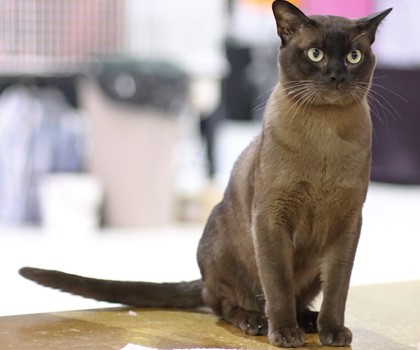
History
The Burmese breed first came to America in 1930 when Dr. Joseph Thompson of San Francisco brought a small walnut brown female cat from Burma. Burmese cats carry surprising weight for their size. Their coats are short and close-lying, and they have a very silky texture. They need very little grooming, usually requiring only some daily petting. You will see a range of styles of Burmese cats, with those with rounder heads and shorter bodies being the show cats. Burmese kittens can be quite spirited. They are playful and fearless, attempting feats beyond their means and landing on their sturdy little rear ends. A Burmese kitten will remain playful well into adulthood. As they mature, their unique intelligence will reveal itself as their personalities unfold.
Description
Loving and sticks to family members like glue. Talkative, friendly and soft. Very curious cat.
Grooming and Physical Needs
Size: Small, lanky.
- Grooming Needs: Weekly brushing is enough to keep the coat shiny and mat free.
- Coat Type: Short and silky, most often presented as borwn-grey overcoat with defined dark brown features.
- Moulting: Little to moderate.
- Exercise Needs: Relatively high energy, some daily play needed to tire out and maintain health.
- Average Life Span: 10-16 years
- Healthcare: Can develop eye, heart, head and ear defects. Check for irregularities every so often.
Behaviour
- Family: Very affectionate towards family members and perfect companion for children.
- Temperament: Energetic, friendly and conversational. Very curious of surroundings and loves to explore.
- Trainability: Learns to fetch and retrieve naturally. Can learn to roll over, sit, and even wave their paw. Can learn to be comfortable in cars.
- Sociability (Other Pets): Loves a fellow burmese but friendly with other cats and cat friendly dogs too.
- Meowing: Talkative but with a quiet meow.
Notes
Infromation Courtesy of The Governing Council of the Cat Fancy Australia and Victoria Inc
